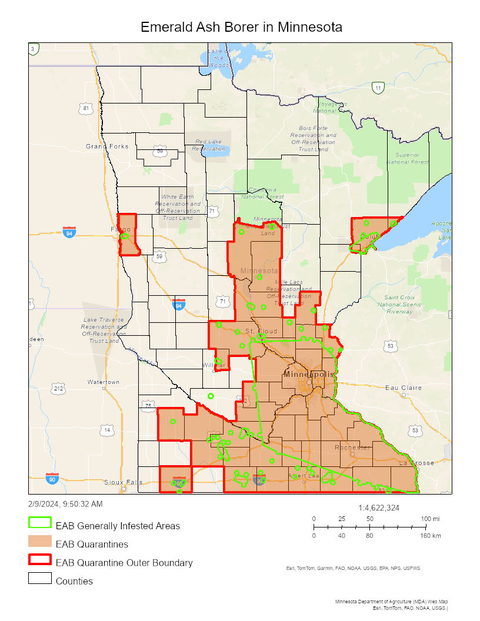Emerald ash borer (EAB) continues to cause problems for ash trees and the people who care about those trees. As always, there’s a lot of good EAB information on the Extension EAB webpage.
EAB has been found in 48 counties in Minnesota
In the past few months, EAB has been confirmed in eight new counties including Crow Wing, Faribault, Lyon, southern Isanti, northeastern Kandiyohi, western Clay, southeastern Cass, northeastern Carlton and southeastern Lake counties. Both the public and the Minnesota Department of Agriculture continue to look for, and find, new locations of EAB.
Warming temperatures aren’t helping
EAB was found in Cass County earlier this year, which was a surprise to some. For years EAB experts shared that the invasive insect that kills ash trees had not been found in plant hardiness zone 3. But the USDA recently updated the zone maps for the first time since 2012 and, while some regions in Minnesota have remained the same, many areas have a new zone.
As Minnesota gets warmer and zone 3 retreats north, more of Minnesota’s extensive ash and black ash forests will become vulnerable to EAB.
The year the ash trees died
In addition to finding EAB in new counties, ash mortality finally hit en masse last spring as many ash trees in southeastern Minnesota and the Metro did not leaf out. This level of high ash mortality in untreated ash trees was not a surprise but was still a stark contrast to previous years of declining ash tree health.
Homeowners and land stewards dealing with ash tree mortality may want to review our recommendation lists for climate-resilient trees as options for replacement.
Herd immunity can protect community ash trees
Professor Brian Aukema and a team of scientists published a paper last March that showed that communities that treated 50% of their ash trees with emamectin benzoate or azadirachtin helped preserve the crown condition of nearby untreated ash trees. This finding may not change the decision-making process for any individual homeowner treating their ash tree. Still, by treating that ash tree they are contributing to a possible overall improved crown health of neighboring ash trees. This finding could be significant for community forestry programs considering the costs and benefits of treating street and community ash trees.
EAB communication matters
Professor Ingrid Schneider led a group of scientists who recently published several papers about how the type of EAB communication matters for public support of EAB forest management. This study looked at how no information, trail-side signs, augmented reality and virtual reality influenced the public support for four different forest management approaches to treat stands likely to be impacted by EAB. An innovative 6-minute video summarizes this work.
- Exploring public perceptions of emerald ash borer management
- Minnesota Department of Agriculture EAB Quarantine webpage
- Mwangola DM, Kees AM, Grosman DM, Norris KE, Maddox MP and Aukema BH (2023) Associational protection of urban ash trees treated with systemic insecticides against emerald ash borer. Front. Insect Sci. 3:990909. doi:10.3389/finsc.2023.990909


